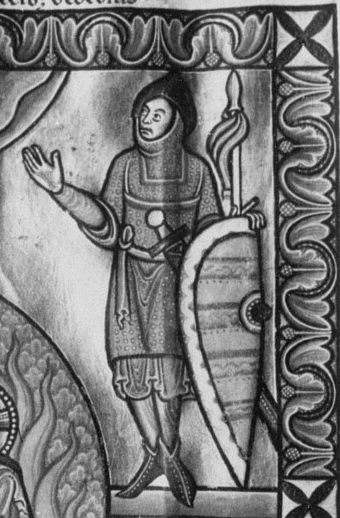Posts: 1,303 Location: Jackson, MS, USA
Wed 06 Jan, 2016 7:51 am
| Kristjan Runarsson wrote: |
| That may be but was that statue carved and added in the 1800s? or was it original to the church and just cleaned up? |
Yes, the statue with the separate coif was carved and added in the late 1800s.
| Quote: |
| I just got through reading a research paper that stated that there is not a single mail shirt with an integrated coif that survives. So if that is true the only evidence for their existence is from art whereas there is at least one separate coif carbon dated to the 1250s and there are illustrations and statues showing separate coifs as early as the 1150s if we disregard the Bayeux tapestry. |
And there is only one extant mail chausse known, despite them being shown on every knight for over a century. Most things don't last for centuries or a millenia. If you have any evidence for separate mail coifs as early as 1150, please share it. The earliest disputed example of which I'm aware is from the Evangeliaire d'Averbode, ULg Ms. 363 fo.16v, from c. 1170, though this may instead be a depiction of the square ventail flap of the previous century.
 Attachment: 155.82 KB
Attachment: 155.82 KB

 Attachment: 54.3 KB
Attachment: 54.3 KB

Posts: 94 Location: Melbourne, Australia
Wed 06 Jan, 2016 1:38 pm
| Kristjan Runarsson wrote: |
| So if that is true the only evidence for their existence is from art whereas there is at least one separate coif carbon dated to the 1250s |
Iron/steel can not be carbon dated. Only organic material.
Posts: 1,303 Location: Jackson, MS, USA
Wed 06 Jan, 2016 4:34 pm
| Michael Harley wrote: |
| Kristjan Runarsson wrote: | | So if that is true the only evidence for their existence is from art whereas there is at least one separate coif carbon dated to the 1250s |
Iron/steel can not be carbon dated. Only organic material. |
The Tofta coif retained leather thongs which were carbon dated. As for C-14 dating iron artifacts, AMS has been effective due to the carbon used in forging. The problem is in having a large enough sacrificial sample.
http://www.tms.org/pubs/journals/JOM/0305/Cook-0305.html
Last edited by Mart Shearer on Thu 07 Jan, 2016 9:08 pm; edited 1 time in total
Posts: 94 Location: Melbourne, Australia
Thu 07 Jan, 2016 2:54 pm
Thanks Mart, very interesting.
Posts: 193
Thu 14 Jan, 2016 9:02 am
| Quote: |
And there is only one extant mail chausse known, despite them being shown on every knight for over a century. Most things don't last for centuries or a millenia. If you have any evidence for separate mail coifs as early as 1150, please share it. The earliest disputed example of which I'm aware is from the Evangeliaire d'Averbode, ULg Ms. 363 fo.16v, from c. 1170, though this may instead be a depiction of the square ventail flap of the previous century.
|
As regards separate coifs, I already pointed out the Bayeux tapestry which seems pretty clear to me. What bugs me is that there are people who only want to allow archeologically confirmed items at events but I think the rules at these re-enactment events can be pretty arbitrary sometimes. At Moesgdaard for example they have now outlawed coifs (separate or not) even though they are visible in the Bayeux tapestry and Vendel helmets and Anglo-Roman helmets with earflaps, cheek protection or face covers are not acceptable either. The only thing they allow are Gjermundbu helmets (nice walk-around here: http://www.drakt.org/Viking/Gjermundbu.html ) and the Spangen type. Some of these rules make sense to me but some don't. The intended logic seems to go: "Just because the Britons/French/Germans/Slavs/Byzantines used equipment X does not mean the 'Vikings' did". However, they allow aventails which are not archeologically documented on 'Viking' helmets and they allow gambesons which are undocumented archeologically before ~1170 (the Dublin specimen).
The Gjermundbu helmet is the only reasonably complete 'Viking' age helmet and it is very popular at re-enactment events where it often features a neck-curtain aventail or even a full ring-curtain. Now... I am failing to see any evidence of a curtain aventail on the remaining Gjermundbu helmet fragments. True, there are two rings on the left hand side of the helmet but you'd expect a closely spaced line of holes to be there if the thing originally had a curtain aventail. Judging by what I see, I'm thinking this helmet may just as easily have had cheek pieces and the rings originally served to attach them to the helmet in a manner similar to this thing:
https://www.battlemerchant.com/images/product_images/popup_images/ULF-HM-19b.jpg
Well in my humble opinion one can go too far with being a stickler for accuracy but if one is going to allow aventails on Gjermundbu helmets why is the following unthinkable?
- The Coppergate helmet dates to the 750s or so and how likely/unlikely is it that these helmets were still being worn by Anglo-Saxon warriors after Lindesfarne and how likely is it that these helmets were scavenged and used by 'Vikings' off of Anglo-Saxon dead?
- Slavic helmets did have aventails and some appear to have had cheek pieces. How likely is it that:
- The 'Vikings' used Aventails too?
- That they obtained these helmets in trade or scavenged them off of dead Slavic raiders or got some on a trip to Kiev?
- Thousands of 'Vikings' went to Byzantium and served there as mercenaries, how likely are they to have brought back Byzantine Equipment? I believe some of the Birka finds bear this out.
- Being in contact with the British/Germans/French, does anybody really believe that Vikings were too dim to pick up on the idea of a Coif by 1066?
- Grave robbery was pretty common in the 'Viking' world, the sagas make that clear. How likely is it that somebody dug up late Vendel age graves and availed himself of the dead man's weapons? Mind you I can see the problem event organisers have with these things. If you allow Vendel helmets you get 20% of your fighters turning up wearing royal de-luxe edition silver and gold encrusted Vendel helmets which makes for a very un-authentic experience for the spectators because there are too many chiefs and not enough indians.
And that concludes my disturbingly long rant on strange equipment rules at reenactment events.
Last edited by Kristjan Runarsson on Thu 28 Jan, 2016 8:12 am; edited 1 time in total
Posts: 114
Thu 14 Jan, 2016 3:12 pm
Hi Kristjan. I do think coifs were in use In Scandinavia by 1066, but what I've been trying to find out is, were in use in the 9th or 10th century? So far I haven't found any evidence.
Aventails were definitely in used by Eastern European cultures at this time, this is true, but all of the artistic evidence from Western Europe (that I've seen anyway) indicates that they used simple spangenhelms, either round or conical, only very rarely having aventails or nasals.
The point you raise about the rings on the Gjermundbu helm is very interesting, so thanks for sharing.
Jason
Edited to correct minor error.
Last edited by Jason O C on Thu 21 Jan, 2016 3:15 pm; edited 1 time in total
Posts: 1,220 Location: Cork, Ireland
Tue 19 Jan, 2016 4:19 pm
| Jason O C wrote: |
I'm beginning to form some sort of idea of the development of helms, before, during, and after the "viking age". In the 6th and 7th centuries we have the Vendel/Valsgarde style (descended from late Roman ridge helms). Then in the 8th century we get hemispherical spangenhelms, like the Benty Grange, Coppergate, and Pioneer helms. It's my belief that the Gjermundbu helm is also from this transitional period, between Vendel and Viking Ages. |
Hi Jason. The way I see it the Gjermundbu helm is a transitional style, but not between Vendel and Viking Ages. I think It's a transitional style between spangenhelms and one piece conical helmets. The construction of the skull uses narrow bands with a singular row of rivets to secure its plates together, this to me indicates that these plates must have overlapped each other. In all other spangenhelms that I'm aware of, the bands are wider and have two rows of rivets, meaning that the plates did not overlap. To me the overlapping plates of the Gjermundbu helm seem similar to a helm kept in the Met Museum. This particular helm is the same in style to 11th/12th century conical nasal helms, except that instead of being made of one piece of iron, it's made up of four overlapping plates which have been riveted together. So I think that the Gjermundbu helm is probably accurately dated to late 10th century.
Posts: 114
Thu 21 Jan, 2016 3:33 pm
Perhaps you are right Stephen. As I said I could be very wrong, but to me the half face mask on the Gjermundbu helm indicates an earlier date.
Jason
Posts: 802 Location: The Welsh Marches, in the hills above Newtown, Powys.
Fri 22 Jan, 2016 7:51 am
| Quote: |
| And that concludes my disturbingly long rant on strange equipment rules at reenactment events. |
but perfectly lucid and valid!
Posts: 802 Location: The Welsh Marches, in the hills above Newtown, Powys.
Fri 22 Jan, 2016 7:52 am
I have a very lovely Gjermundbu by Jeff Hildenbrant and it sits in my store devoid of mail as its a decision I just cant make at the moment. Oh the torment!
You
cannot post new topics in this forum
You
cannot reply to topics in this forum
You
cannot edit your posts in this forum
You
cannot delete your posts in this forum
You
cannot vote in polls in this forum
You
cannot attach files in this forum
You
can download files in this forum

